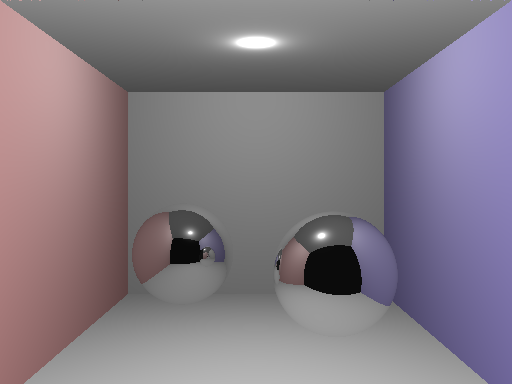omp compiler directives
- add
-fopenmpto theCFLAGSline in theMakefile - using integer variables
tidandncoresinmain()find out how many cores there at your disposal via this piece of code:#pragma omp parallel private(tid) { if((tid = omp_get_thread_num())==0) ncores = omp_get_num_threads(); } - set integer variable
chunkto the number of rows (height of the image to be ray traced) divided by the number of cores—this stipulates how many rows of the image each core will process—we parallelize the ray tracer by chopping up the image into horizontal bands, and having each core process each band of pixels simultaneously - insert this compiler directive immediately above the nested
forloops iterating over the image pixels (x,y):#pragma omp parallel for \ shared(...fill this in...) \ private(...fill this in...) \ schedule(static,chunk) - make sure that the nested loops write to
img, an array of (pointer to) typergb_t<unsigned char>, allocated to sizew*hand that the code inside the loops does not write tostd::coutdirectly—provide a second doubly-nested loop to ouptut the pixels after the parallelized nested loops finish
obj->getlast_hit()
- rewrite
ray_t::trace()so that it no longer needs andobject_t *last_hitargument - the old
model_t::find_closest()routine won't work anymore because its initial design assumed that a ray would hit any given object only once (and reflect). This won't work when there are two (or more) rays hitting an object at the same time or when transparent objects have volume, through which the transparent ray needs to exit, once it has penetrated it—see Asg 2.
This means, particularly for transparent spheres, that the ray will hit the sphere twice, and so thefind_closest()routine needs to be rewritten:- rename the local variable
mindisttoclosest_distand set it toINFINITYinstead of to-1 - rename the variable
objtoc_objand rename the variableclosesttoclosest_obj - rename the local variable
disttoc_distand rename the lcoal variablemindisttoclosest_dist - ensure that as arguments to
find_closestyou now have fourvec_tpass-by-reference variablespos,dir,hit, andNand onedoubledist - remove the
obj==last_obj ||evaluation from the initial call toobj->hits()—the current object should only be skipped if the returneddist < 0 - only record the closest distance, closest object,
closest hit point, and closest normal if
(0.00001 < c_dist) && (c_dist < closest_dist)(the distance to the intersection point must be non-zero) making sure that you calledobj->hitswith argumentspos,dir,c_hitandc_N(note thathitswill have to be rewritten; see below) - by "recording the closest distance" I mean that
closest_dist,closest_obj,closest_hit, andclosest_Nall get set toc_dist,c_obj,c_hit, andc_N, respectively, if the aboveifstatement istrue - note that
model::find_closest()must now overwrite the incoming argumentsvec_t hitandvec_t Nand addclosest_disttodistat the intersection point only ifclosest_objis notNULL(that is,hitandNget set toclosest_hitandclosest_N, respectively). - finally, return
closest_obj
find_closestfunction in its logic should resemble a typical "find the minimum value in an array" problem. We're just settingdist,hit, andN(instead of a single value) and doing so for the closest object (instead of the minimum). - rename the local variable
- rewrite all the objects'
hits()routines so that they overwrite the incoming hit point and normal pass-by-reference arguments—the objects' (internal) normal must not be altered, and nolast_hitshould be stored by the object (this should be removed from theobject_tclass).
For the plane, it will just set the incoming argument to the plane's normal. For the sphere, the incoming argument will be set to the sphere's normal at the intersection hit point (N = 1.0/radius * (hit - center)); these variables are handled in a similar manner todist, the distance to the closest hit point from the ray's current position, meaning that they are all pass-by-reference
#pragma omp
directive to run the serial version (once your parallelized version
works); on my dual-core laptop, the parallel version takes 1.517
seconds, while the serial version takes 2.934 seconds, not quite
a factor of 2 reduction, but 1.9, which is noticeable. On a
quad-core machine, the speedup should be even better.
